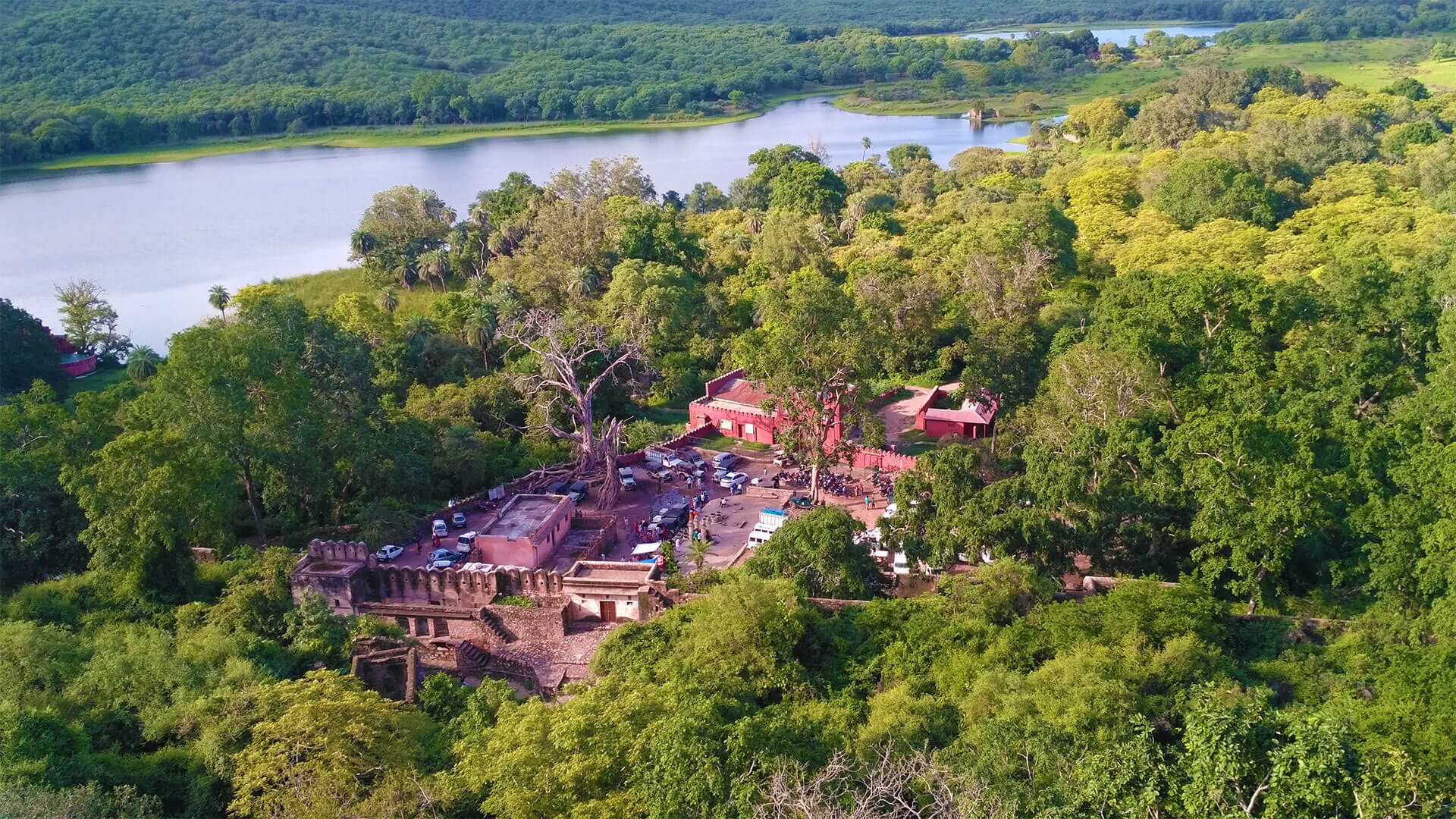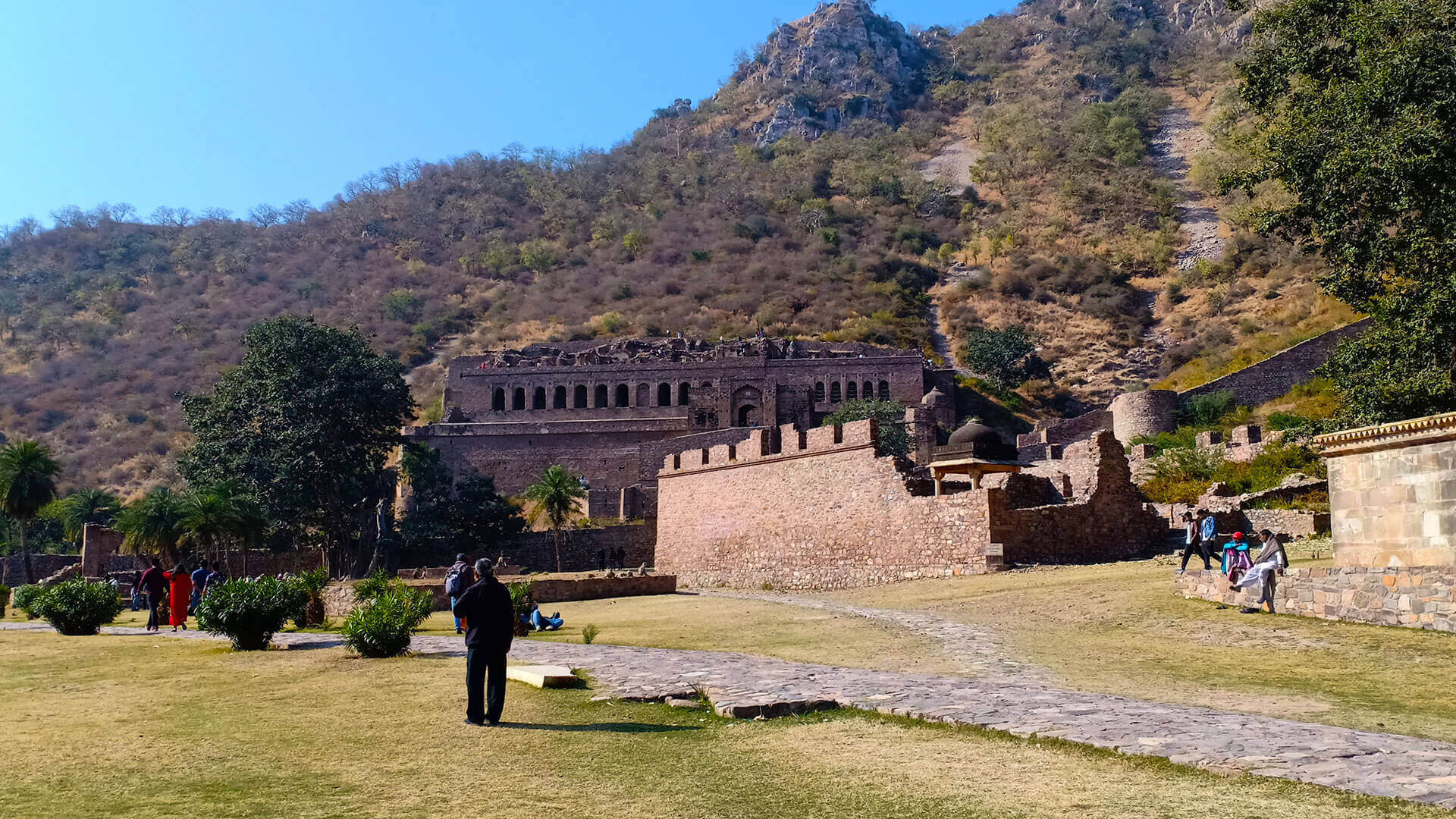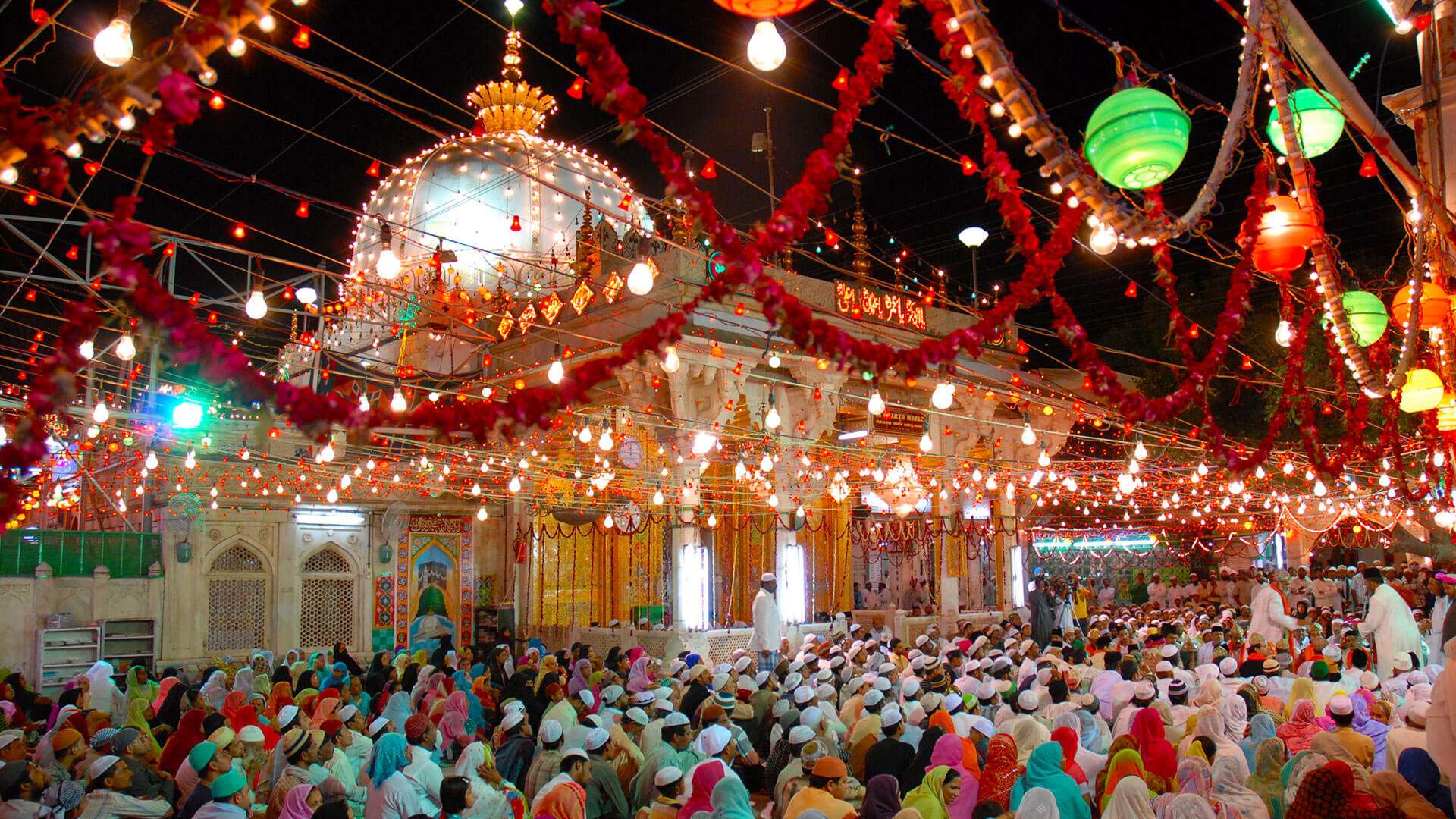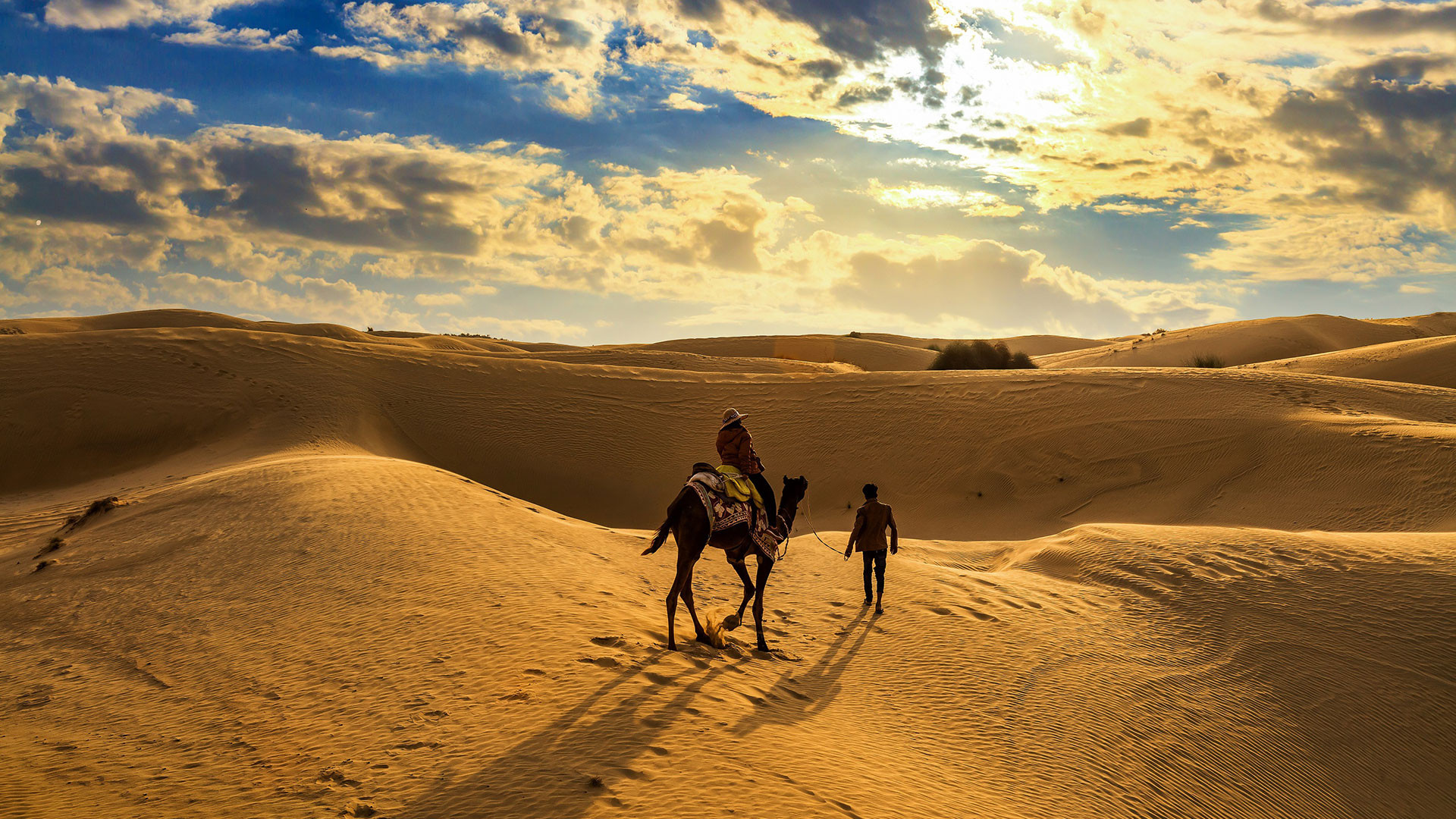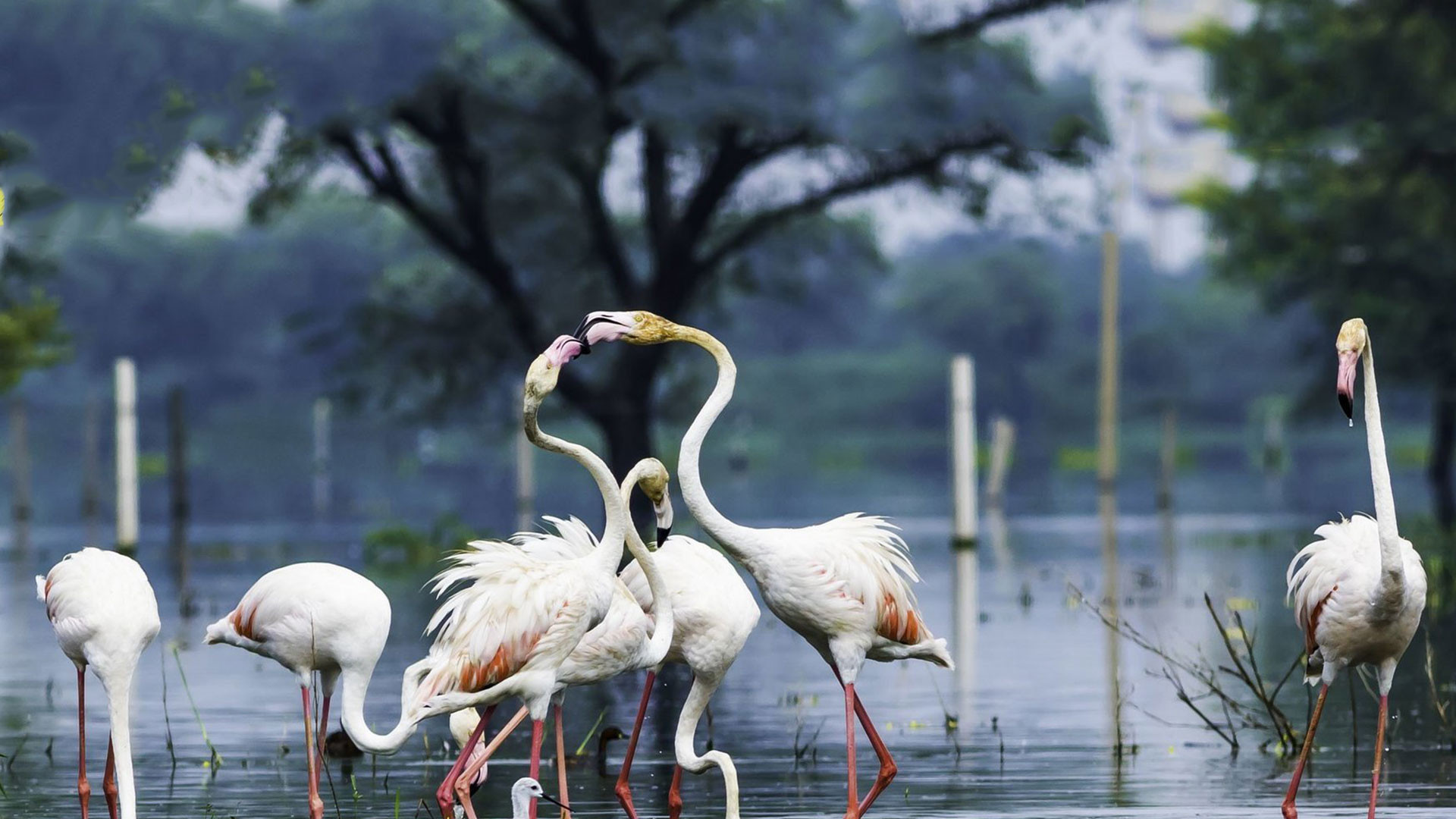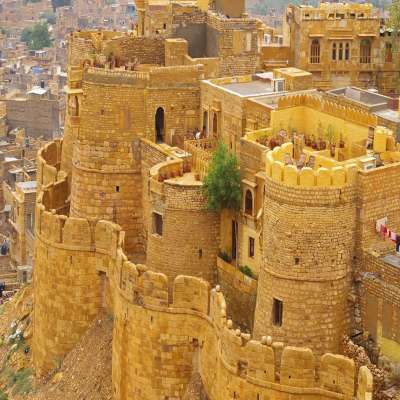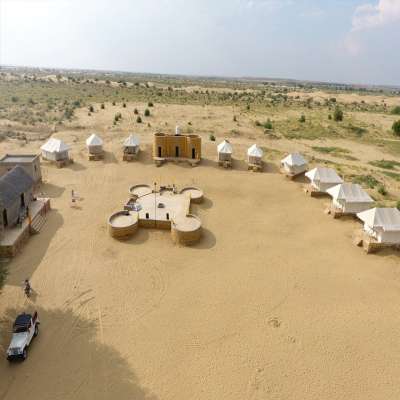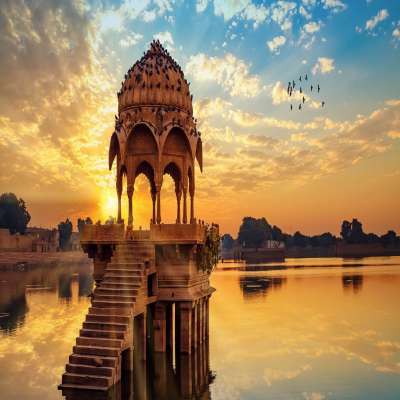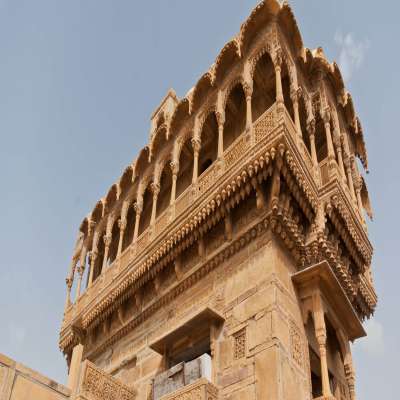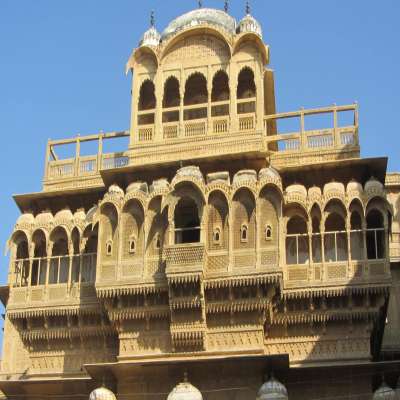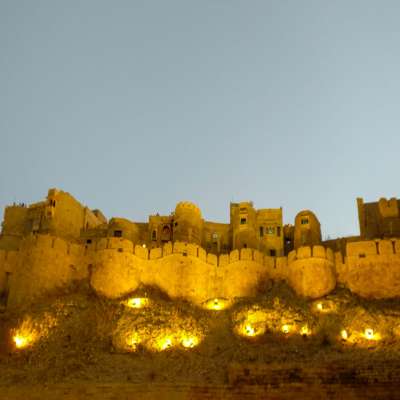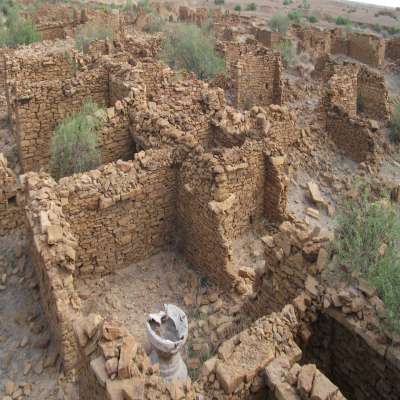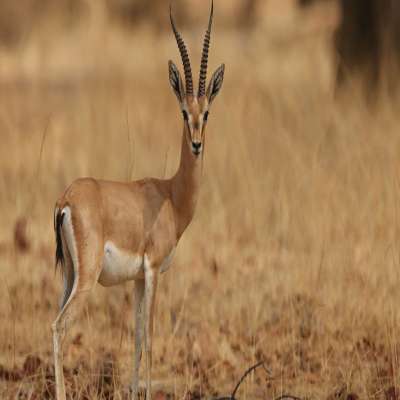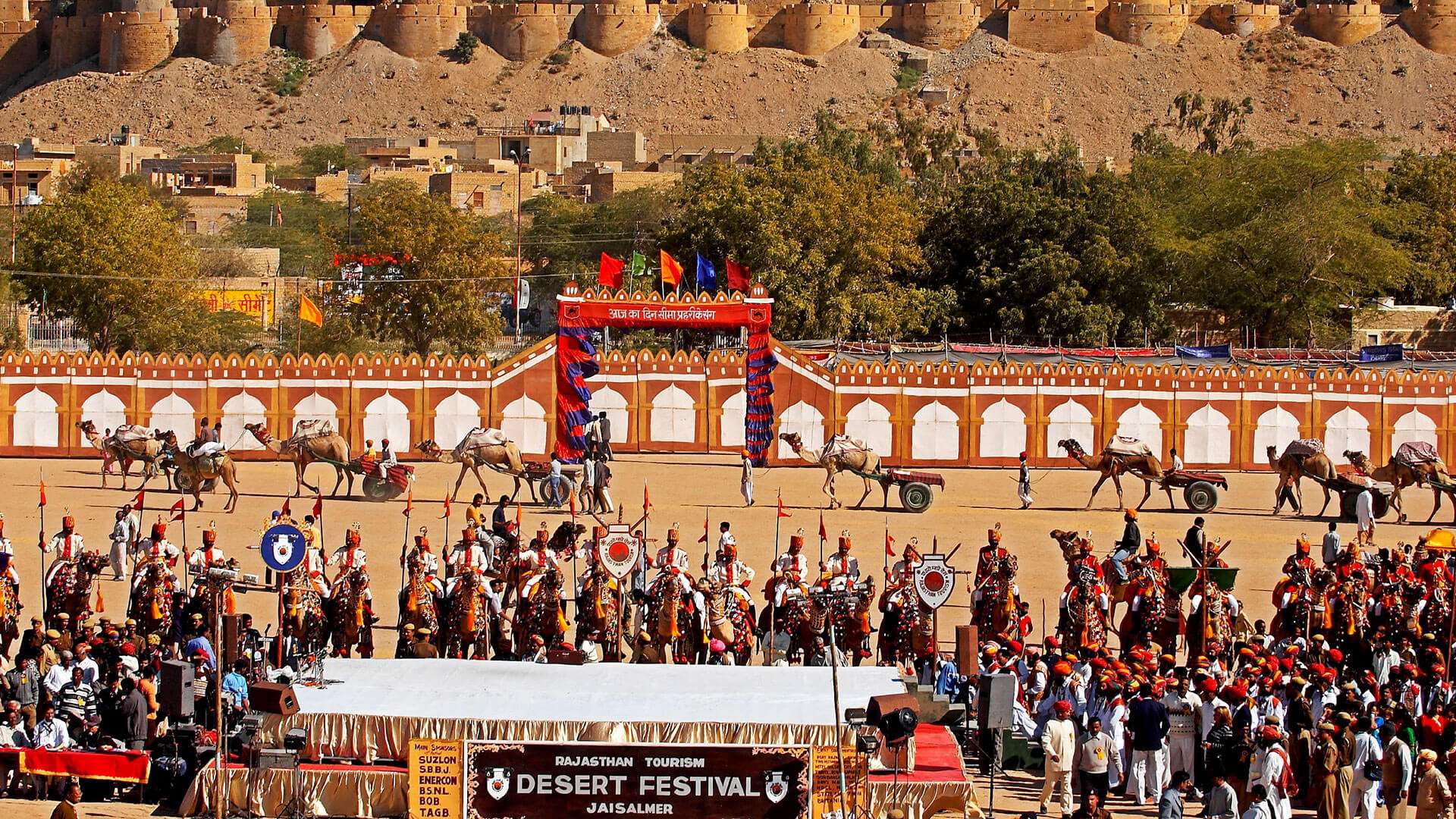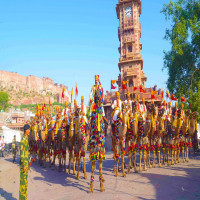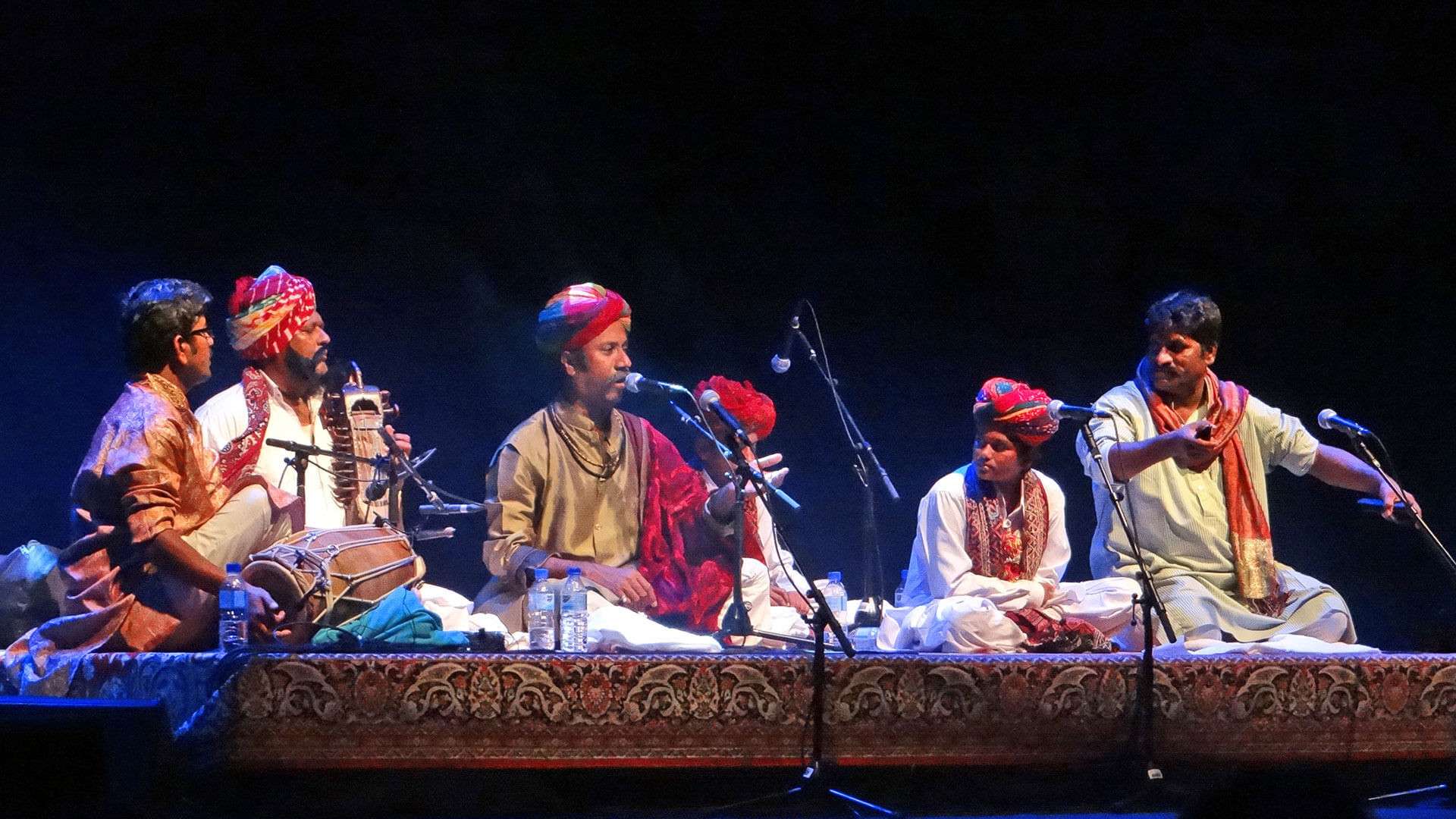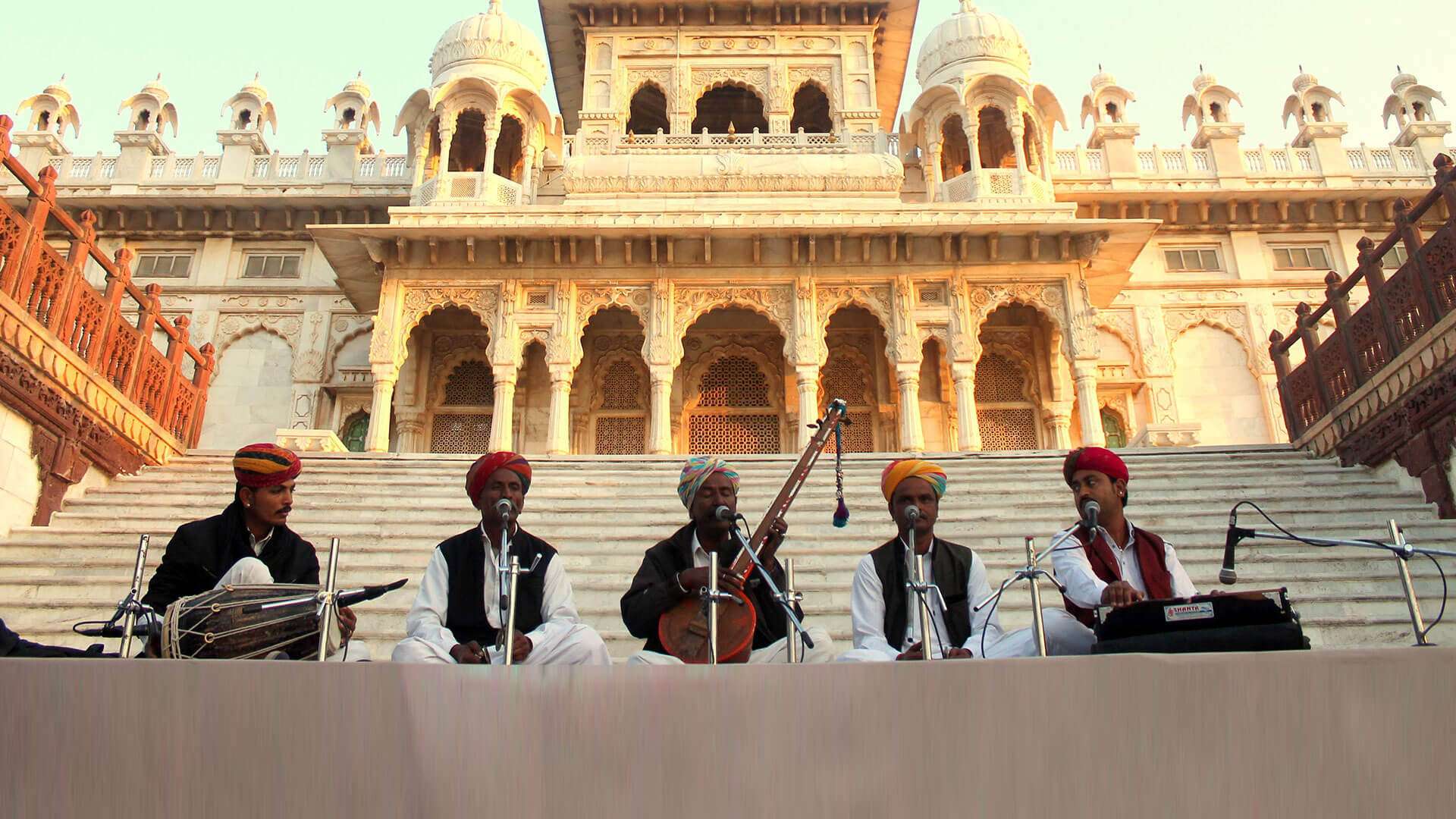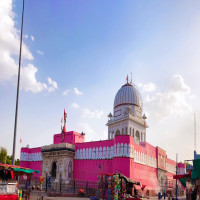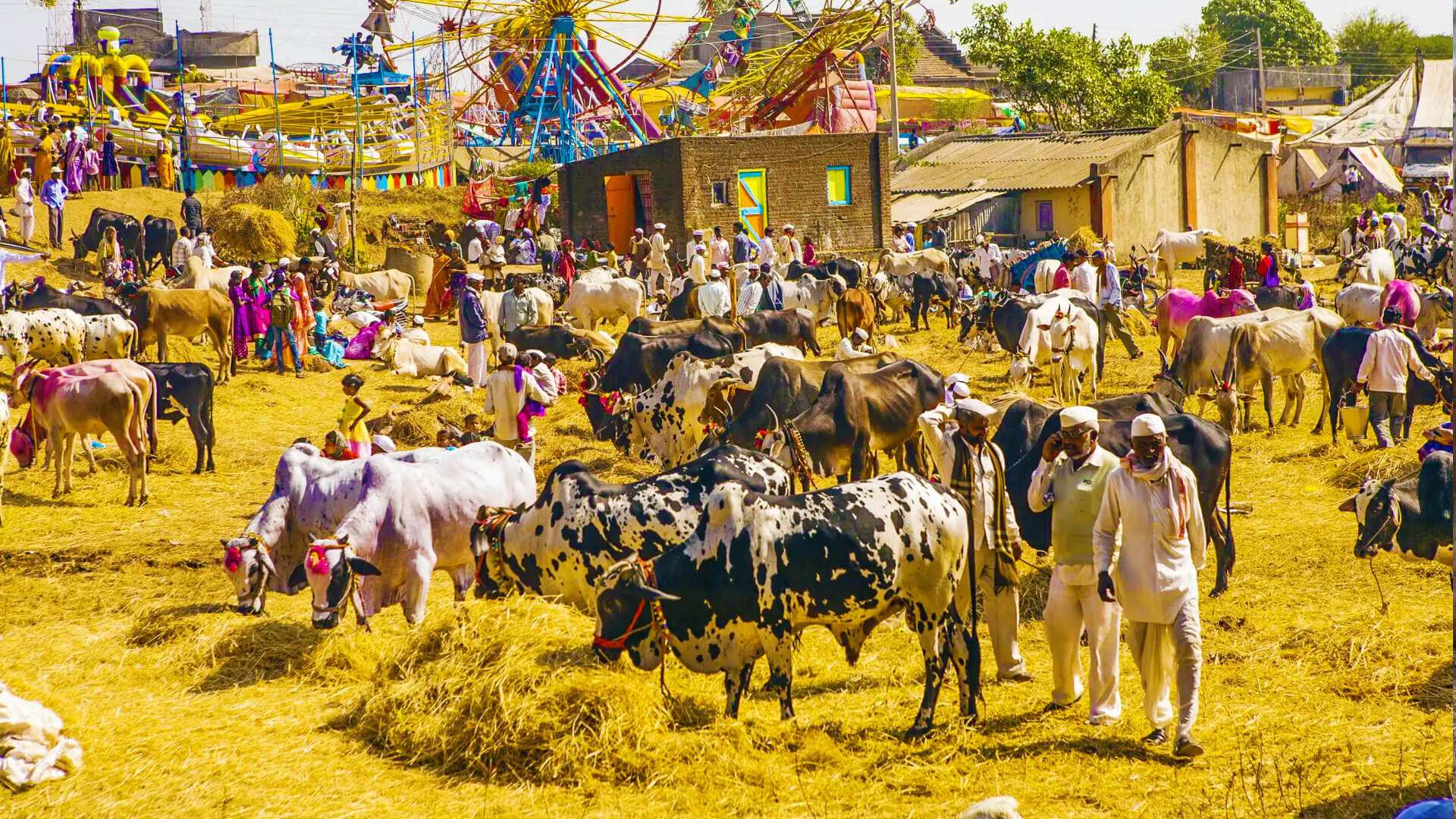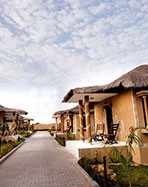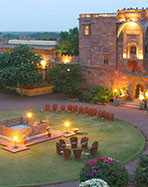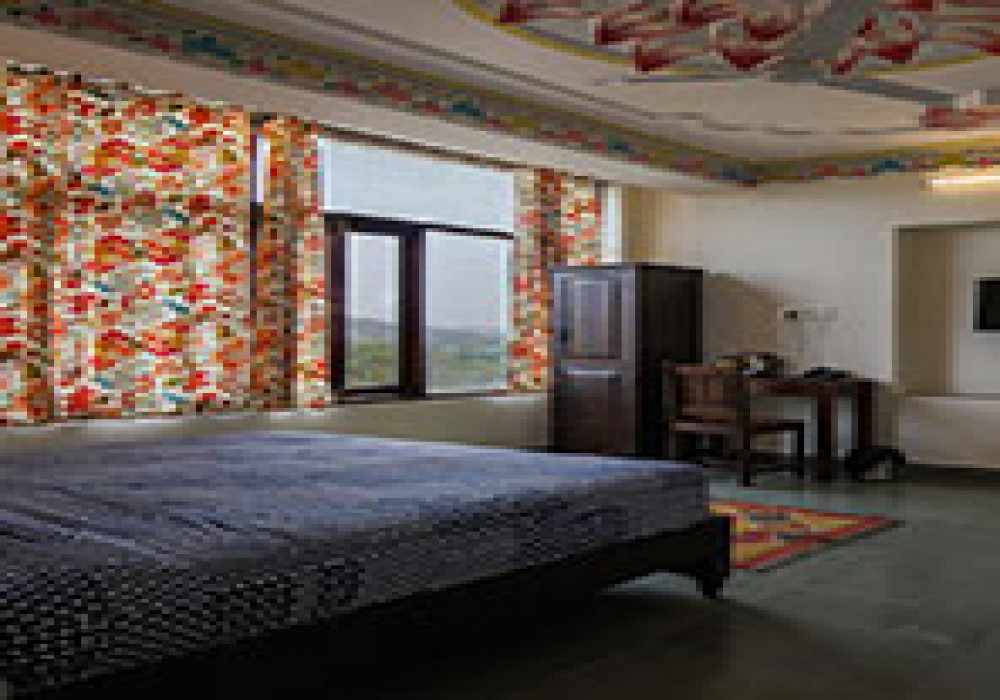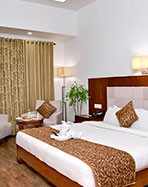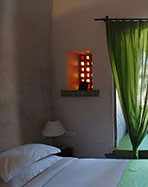The Sonar Quila, or the Golden Fort, is the heart of the city of Jaisalmer, with the Thar Desert bordering it in north-western Rajasthan. This medieval fortress seems to rise about the surrounding sandy landscape like a mirage from erstwhile times. This fort is a UNESCO World Heritage Site, complete with three layers of walls, 99 turrets, and four imposing gates. Like the Carcassonne in France, this is one of the only living forts in the world. This is because the fort houses many Havelis or vintage homes, hotels, and shops, home to about 2,000 people. About 25% of Jaisalmer’s population resides here. Generations after generations have lived and prospered here, and they continue to do so, making it India’s last and only living fort.
Located on Fort Kothri Road, the Jaisalmer Fort is an iconic landmark of the city. It is one of the top tourist destinations in the city, alongside the Thar Desert, World Fossil Park, Gadisar Lake, Nathmal Ji Ki Haveli, Mandir Palace, and more. Let us look at multiple facets of the fort and what makes it unique and the most popular attraction in Rajasthan.
Best Time to Visit Jaisalmer Fort Rajasthan
Since the Thar Desert surrounds the Fort, summers can be unbearably hot and sultry here. The best time to visit Jaisalmer Fort is the winter season – between October and March. The overall weather conditions are friendly and extremely pleasant that, make it easy for visitors to cover the entire fort during sightseeing tours. There is no Jaisalmer Fort entry fee for visitors. To enter Fort Museum, the entry fee is Rs. 50 per head for Indians and Rs. 250 per head for foreigners. If visitors are carrying a camera, then they need to pay Rs. 50 for still cameras and Rs. 100 for video cameras.
History of Jaisalmer Fort Rajasthan
The fort is believed to have a rich history dating about 860 years back. For most of these years, the fort was actually the city of Jaisalmer. It was much later, in the 17th century, that people started settling on the outskirts of the fort's walls.
Built in 1156 AD, this is the second oldest fort in the history of Rajasthan. It was built by Raja Rawal Jaisal, a Bhatti Rajput king. Built on the Trikuta Hill along the Thar Desert, it was positioned strategically along the east-west caravan route that connected this part of the country, the entire Central and Middle-East Asia, with North Africa.
The fort walls are made from sandstone which gives it a gleaming golden look, especially during the day, which is why it is known as the Sonar Quila. Being a prominent part of the erstwhile trade route in India, the fort became the home to many traders and merchants who constructed Havelis, temples, shops, palaces, etc., inside the fort premises. Bazaars or markets were also set up to facilitate trading.
In about 1299 AD, Alauddin Khilji sieged the fort. The fort remained under the Delhi Sultanate for many years but was finally taken over by the local Bhatis. Between 1530 and 1552, the fort came under the attack of a local Afghan ruler, Amir Ali. However, Rawal Lunakaran won the war, and Amir Ali had to withdraw troops.
Later, in the sixteenth century, the fort was again attacked by Emperor Humayun. Consequently, Rawal Lunakarn’s daughter was wed to Akbar, and the control of the fort was passed on to the Mughals. The Mughal reign lasted till 1762, after which Maharawal Mulraj fought the Mughals and took control of the Jaisalmer Fort.
Due to a treaty with the East India Company, the fort continued to be in the control of the Rawal rulers during the British Raj. With new ports and maritime trade growth, the ancient trade route slowly lost significance. As a result, Jaisalmer’s importance as a trading juncture was also lost in the twentieth century. Jaisalmer Fort's history is eloquently expressed in the architectural supremacy of the fort.
Jaisalmer Fort is undoubtedly an architectural beauty. It is an eloquent depiction of Rajasthani architecture with a beautiful blend of local designs with Mughal styles.
Four beautifully carved entrances to the fort – Akshaya Pol, Ganesh Pol, Hawa Pol, and Suraj Pol. The Suraj Pol receives the city’s first rays of the sun. These gates were once guarded by soldiers and backed by cannons.
The fort is 460 meters long and 230 meters wide. The height of the hill on which the fort was constructed is 76 meters.
The fort’s design depicts circular bastions and double fortification walls, giving it an advantage during wars and battles. To facilitate easy movement of soldiers during battles, there’s a pathway separating the outer and the inner fortification walls. The other interesting feature is the pitching wall that ensures that the sandy soil of the hill is held in place.
Jaisalmer Fort architecture is characterized by the ornate umbrella-shaped cupolas or the chhatris. There are delicately carved screens that provide shade from the burning sun.
Click Here for Exciting Jaisalmer Tour Packages
Inside the fort premises, there are ancient havelis built in the traditional style. Each haveli is a large house characterized by shaded balconies and multiple courtyards. The entire city has been planned intricately and aesthetically with extensively planned streets and a drainage system called the ghut nali. The system was built to drain away the rainwater in all four directions successfully from the fort.
The other notable feature of the fort is the presence of many royal historical structures. For example, the Moti Mahal or the Salem Singh Ki Haweli was built in 1815, featuring a peacock-shaped roof and intercepted multiple balconies. The other structures are Akhai Vilas, Gaj Mahal, Sarvottam Vilas, and Rang Mahal.
Click Here for Online Flight Ticket Booking
Top Attractions Near Jaisalmer Fort
Besides exploring Jaisalmer Fort, visitors can also check out other awe-inspiring attractions that speak volumes about the rich history, culture, architectural brilliance, and beauty of the destination. Look at some of the major attractions near Jaisalmer Fort, and add these places to your bucket list.
1. Bada Bagh
Built by Maharawal Jait Singh, Bada Bagh or huge garden, was constructed as a memorial to brave and chivalrous soldiers who lost their lives defending their land. Cremation of nobles and members of the royal family also took place here. Intricately carved royal edifices scattered amidst green spaces create a stunning look.
2. Patwon Ki Haveli
Built by a renowned trader of Jaisalmer, Guman Chand, Patwon ki Haweli draws many tourists who love checking out the intricately carved mansion. Huge corridors, rooms, and arched add to its beauty.
3. Salim Singh Ki Haveli
It is another popular attraction in Jaisalmer worth exploring. With a beautifully carved peacock perched atop the mansion's roof, the haveli is known for its unique architectural elements. Also referred to as Jahaz Mahal, the haveli resembles the stern of a huge ship. The haveli has 38 balconies.
4. Gadsisar Lake
Surrounded by magnificent temples, stunning chhatris, and carved structures, the Gadsisar Lake looks simply stunning in the evening. Visitors love boating in the lake while admiring the beautiful views, taking them back to erstwhile royal times.
5. Sam Sand Dunes
The vast expanse of golden-coloured sand dunes attracts thousands of tourists every year. The sands seem to shimmer, bathed in the gentle moonlight. Enjoy bonfires, fold music, and folk dances by local performers. Jeep and camel safari are available for visitors who wish to enjoy the picturesque vistas.
6. Desert National Park
Wildlife lovers, nature enthusiasts, photography aficionados, and soul-seekers love visiting Desert National Park, the largest animal habitat in the country. Known for unique wildlife, flora, and fauna, these attractions must be a part of every tourist’s wishlist.
7. Kuldhara Village
If haunted places, stories, etc., give you a sense of thrill, visit Kuldhara, an abandoned village near Jaisalmer. This ghost town has no sign of human habitation and is lying abandoned for centuries.
Interesting Facts About Jaisalmer Fort
There are several interesting facts associated with the Golden Fort. Some of the Jaisalmer Fort interesting facts are
Mughal Architectural Elements. The fort has a lot of Muslim architectural influences primarily because it fell into the hands of Mughal rulers later on, who added typical styles to the fort. Allauddin Khilji was one of the Mughal rulers who invaded the fort and annexed it to his kingdom,
Click Here for Hotel Reservations
Rich Historical Past. Between 1530 and 1551, the fort was the ground for half-Jauhar practice under the rule of Raja Rawal Lunkarna. Amir Ali, an Afghan local clan ruler, invaded the fort during his reign. While the women were preparing for Jauhar, there was little time to complete the entire practice. As a result, the practice was halted in between. This is why it is called half Jauhar. Later, the king killed all the women before the foreigner could enter the fort. However, tragically, Rawal Lunkarna won the battle against Amir Ali.
Changing Colour of Fort. The fort changes its colour throughout the day. Visitors look forward to witnessing this change at least once during their stay at Jaisalmer.
Ancient Temples. Inside the Jaisalmer Fort, the Laxminath Temple and the Jain Temples are must-visit places. Thousands of devotees visit these temples to respect the divine deities.
Adventure-based Activities. People who wish for more thrill and adventure trek the entire hill to reach the top and have a panoramic view of the city. This activity is the best way to explore multiple facets of the fort and learn more about its architectural splendour.
Film Connection. Sonar Kella’, or The Golden Fortress, is a detective story based on this fort. The famous Bengali filmmaker Satyajit Ray filmed the classic movie here, in the fortress itself.
World Heritage Site. In 2013, along with Amber Fort, Chittor Fort, Kumbhalgarh, Gagron Fort, and Ranthambore Fort, Jaisalmer became a part of the World Heritage Site during the 37th meeting of the Committee at Phnom Penh.
Royal Havelis. The Havelis inside the fort built by merchants are also made from yellow sandstone with ornate carvings. Many of these Havelis have stood there for 100+years. These are usually huge Havelis spread across multiple floors. Each of these has many rooms. Most of them have characteristic archways, balconies, doors, and windows. A few of these Havelis are now converted into museums, but some of these still house the descendants of the builders. Some great examples of the Havelis are – Shree Nath Palace which was the residence of the Jaisalmer Prime Minister. The Vyas haveli is a 15th-century-built building and is home to the successors of the original builder.
Click Here for Self-Itinerary with Trip Planner Tool
How to Reach Jaisalmer Fort Rajasthan
Jaisalmer is well connected with its neighbouring cities and metropolitan cities across India. Tourists can travel to the city by road using car and train. Many direct and connecting trains run between Jaisalmer and other prominent cities in Rajasthan and Northern India.
- Nearest Major City. Jodhpur
- Nearest Airport. Jodhpur Airport
- Nearest Railway Station. Jaisalmer Railway Station
- Distance from Jodhpur. 281.2 km
By Air. There is no airport in Jaisalmer. The nearest airport is Jodhpur Airport, about 275 km from the city centre. Jodhpur Airport has direct flight connectivity from metros like Delhi, Jaipur, Mumbai, Surat, and Bangalore. Visitors can hire taxis or cabs or take a train to reach Jaisalmer.
- Distance From Jodhpur Airport. 328.3 km
Here is a list of Indian cities from where flights are available to Reach Jaisalmer Fort Rajasthan
By Train. Since Jaisalmer Fort is right in the centre of the city. It is about 1.8 km from the Jaisalmer Railway Station. It is within walking distance from most hotels and guest houses. Visitors can also travel in local autorickshaws or rickshaws to travel up to the Golden Fort.
- Distance From Jaisalmer. 1.8 km
By Road. Jaisalmer is well connected by road to major cities in Rajasthan and other states. The destination is connected with well-maintained and metalled roads. Both state government and private buses ply their services to the destination.
- Distance from Barmer. 157 km
- Distance from Jodhpur. 262.6 km
- Distance from Bikaner. 329.5 km
- Distance from Ajmer. 464.8 km
- Distance from Jaipur. 593.8 km
- Distance from Kota. 638.2 km
- Distance from Delhi. 772.4 km
Frequently Asked Questions About Jaisalmer Fort Rajasthan
Q1. Why Jaisalmer Fort is famous?
A1. The fort acts as a protective fence to the entire city of Jaisalmer. In fact, it is the only living fort in India, with more than 2,000 people residing inside the fort.
One of the main tourist locations in Jaisalmer, the fort’s sandstone makes it an impressive golden hue during the daytime and a dull honey-gold colour during sunset.
Q2. Who built the fort of Jaisalmer?
A2. The fort was built by Raja Rawal Jaisal, a Bhatti Rajput king, in 1156 AD. The king ruled Jaisalmer between 1153 and 1168 AD. Due to a feud between him and his half-brother, Jaiswal was driven out of Laudrava, the capital of the Deoraj kingdom.
While passing through the Trikuta Hill, Jaiswal met Sage Eesul who told him a mythological story where Krishna had prophesied that one day a Yaduvanshi descendant would rule this area. The prophecy was marked on a rock near a spring created by Krishna. Jaiswal was encouraged to set up his kingdom here and built a fort made from mud in 1156 AD.
Q3. How much time is required for Jaisalmer Fort?
A3. Approximately three to four hours are required to cover the nook and corner of the Jaisalmer Fort. The fort can be visited at any time between 0600 hours to 1800 hours by visitors. The Museum at the Fort Palace opens between 0800 hours and 1800 hours (April till October) and 0900 hours and 1800 hours (November till March). The Jain Temples - Sambhavnath, Rikhabdev & Chandraprabhu - are open between 0800 hours and 1200 hours, and the other temples are open between 1100 hours and 1200 hours.
